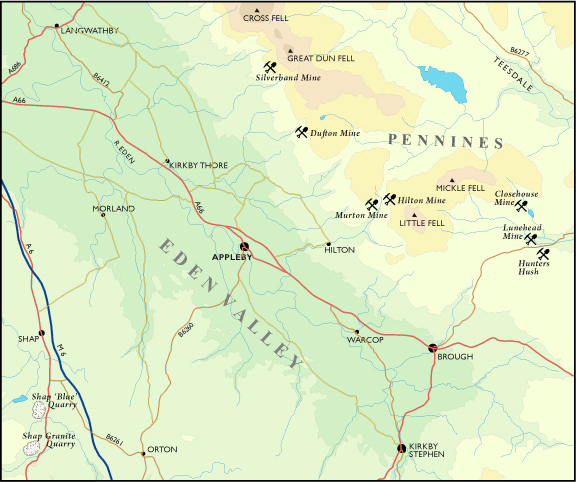Categories
Other Shop Pages
Currency
CUMBRIA - THE WESTERN PENNINES & SHAP
The higher Pennine summits fall away in a steep escarpment along the Pennine fault forming the eastern edge of the fertile Eden valley. At higher altitude on the east side of the faults the strata consist of alternate limestones, sandstones and shales of lower carboniferous age and it is in these that most mining has taken place. Being in the outer
zone of the Pennine orefield, barytes is the dominant gangue mineral and although in earlier times the mines were worked on a small scale for lead a new lease of life was injected into them when barytes became a saleable product. The occurance of fluorite at Hilton mine is unusual, the veins worked there forming part of a small fluorite outlier within the outer barite zone.
On the western edge of the valley, just South of Shap, an area of granite is exposed containing large pink feldspar crystals giving it its distinctive colour. A little further north lies
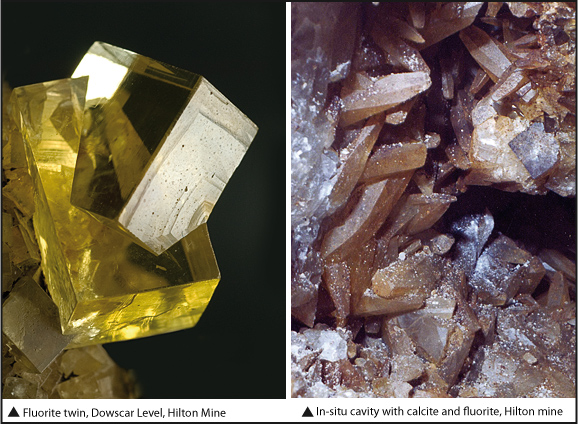
the Shap ‘blue’ quarry, working rocks of the borrowdale volcanic series that have been highly altered by the heat of the nearby granite intrusion. The Howgill Fells above Kirkby Stephen form the Southern boundary. There are mines here too and whilst fluorite, galena and a little azurite have been found, specimens are only of locality interest.
Mineralogical Interesting Locations
Dufton and Threlkeld Side Mines
Situated in the higher part of Rundale Beck they were part of the London Lead Companies leases and were worked by that company for lead between 1821 and 1873. Barite production commenced in 1882 and continued until 1897. In more recent times Sanbar minerals worked the dumps in the 1980’s. Of the two mines, Dufton was the more productive, working a number of veins where mineralisation was predominantly in the form of small flats containing galena, barite and aragonite, the later reported by Davison and Thompson as occurring as Flos-Ferri and of a fine fibrous type. They also report sphalerite and smithsonite although other references suggest there is no zinc mineralisation here. Mineralogically it is known for a reported single barite crystal weighing 50 kilos and occasionally smaller ones up to about 20cms do come on the market. Unlike other mines on the escarpment, barite crystals from Dufton often have complex multi-terminated crystals.
Hilton Mine
Another mine worked by the London Lead Co. in the 19th century for lead and subsequently for barytes by various operators between 1896 and 1919 and 1930 to 1939. Famous as the source of some of the finest yellow fluorite groups ever found. The mine worked the veins on the south side of the Scordale valley and it is in the flats worked in Dowscar level that the best specimens were found. Many of the finest specimens consisted solely of fluorite displaying transparent, deep yellow lustrous crystals with the
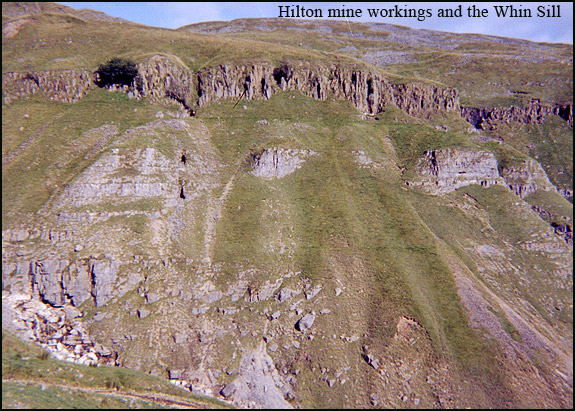
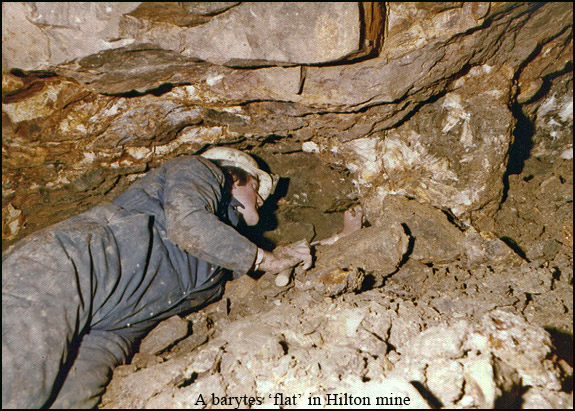
most well developed and largest crystals forming twins whilst the surrounding smaller crystals show no sign of twinning. The quality of the specimens is a summation of, the frequency of twinned crystals; the internal clarity and absence of internal fractures; their mirror like surface lustre and their colour. Fluorite also occurred in association with barite, quartz and galena crystals. Pyrite inclusions within the fluorite are common.
Other cavities within the flats contained sticky clay-filled vughs with large groups of clear and white platy barite crystals often up to 25cms across. At the back of the flats, fluorite dies out and cavities of nail-head calcite and barite pseudomorphs after witherite occur along with barite. Galena crystals were common although oxidised and not to the size of those from the nearby Weardale and Alston mines. Cerussite and anglesite crystals occur but are not common. Within the deads large balls of pyrite up to 25cm diameter and usually encased in calcite were occasionally found. An unusual pod of Nickel mineralisation was found in the 1980’s with annabergite, niccolite, gersdorffite and millerite. Wilson’s level below the flats was a source of white to grey chisel type barite crystal groups. The hillside further to the west is intriguingly called Amber Hills but the levels are fallen in. Hilton and Murton mines lie on MOD property and access to all the mines is no longer allowed.
During the 1930's and 1940's, Hilton mine was worked for barytes by Bill Wharton, the mine featuring on a British Pathe newsreel in 1949. This short film would have been shown at cinemas along with other news items before the main feature film.
The link to the video is Miners work in mine high in the Pennines (1949) (youtube.com)
Murton Mine
Workings on the north side of Scordale including Mason’s Hole, a large opencast which is thought to date from the 14th century. It is probable that the 70 tonnes of witherite production reported in 1896 came from the Murton workings. Yellow fluorite occurs in the veins but not of the quality found at Hilton. Barite occurs in chisel shaped crystals with
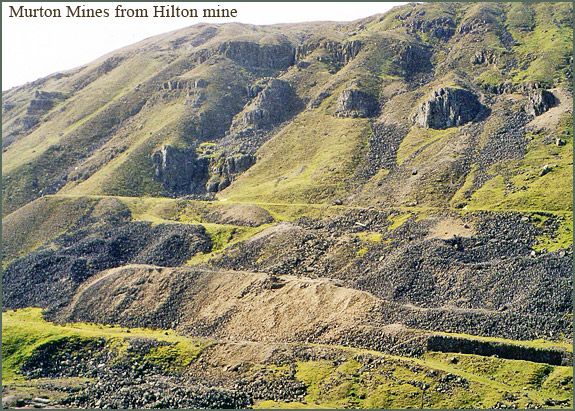
calcite, quartz and in places quite rich malachite and azurite staining. Witherite in brown semi-transparent nodules up to 15cm occur on the ridge above Mason’s Hole.
Shap Granite Quarry
Now only occasionally worked but in recent times has produced a variety of minerals described in detail in UK Journal of Mines & Minerals, Issue 22. Hand specimens of large feldspar crystals with smoky quartz and fluorite in purple octahedrons occur whilst barite,
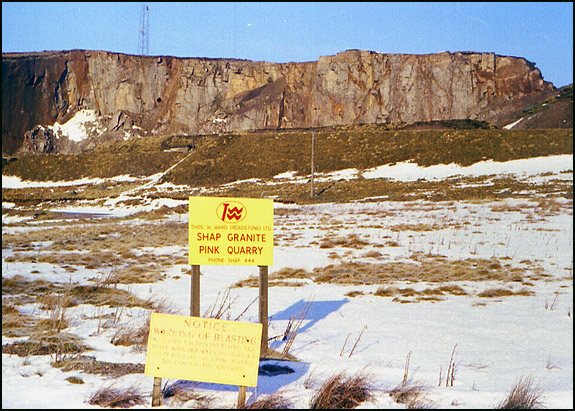
bismuthinite, pyrite and molybdenite are not uncommon. Rare micro material found includes apatite, bastnasite group minerals, bavenite, bertrandite, chalcopyrite, cosalite, epidote, magnetite, milarite, scheelite, rutile, titanite and wulfenite.
Shap ‘Blue’ Quarry
Epidote in opaque crystals to 2cms and garnets in opaque to semi-transparent red-brown crystals up to 7cms were relatively common here with crystallised quartz, calcite, pyrite and chalcopyrite.
Silverband Mine
An old mine worked for lead in the seventeenth century and by the London Lead Co. from 1820 to 1879. Subsequently it was worked underground by Laporte’s for barytes between 1939-1963 and later by opencast methods in the 1970’s and 1980’s. Laportes built two aerial ropeways to get the product to Long Marton station, evidenced by a line of derelict pylons that still survive. Veins and replacement ore bodies that occur here are mostly found in the Great Limestone.
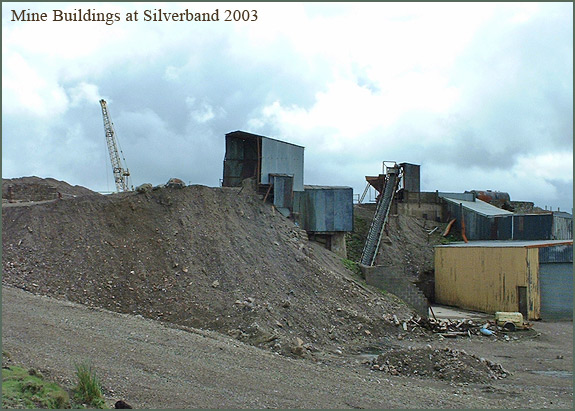
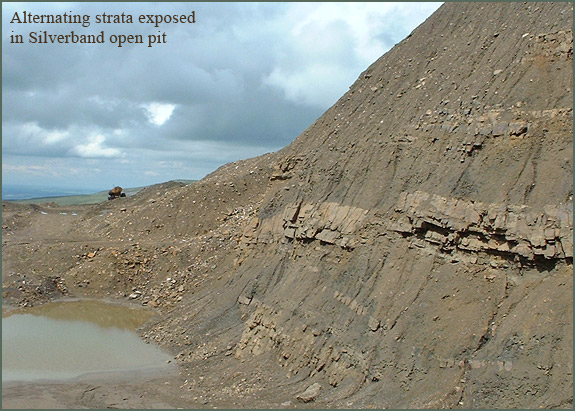
Large crystals of barite have been found here and some smaller examples were of sufficient clarity to be faceted. Both tabular and ‘chisel’ shaped crystal forms occur here. A find in 1952 produced complete transparent single crystals with unusual yellow/ brown colour zoning. Besides barite, the ore-bodies contained smaller amounts of aragonite, calcite, galena and sphalerite with witherite being reported by Bramall. Attractive bright pyrite crystal groups weather out of the shales above the Great Limestone.
Two other mines lie in the same geographical area but are situated just over the county boundary in Durham:-
Closehouse Mine
Opencast workings are known to pre-date the acquisition of the mine by the London Lead Co. in 1770. They worked the deposit for lead until relinquishing their lease in 1880, total production though is thought to be small. In 1939 the property was opened up again and work began mining and opencasting the large barite deposit. A number of owners have subsequently continued this work, it only closing as recently as 2000. Old mine reports refer to galena and pyromorphite in the southern opencast at West hush. Although essentially a homogeneous massive barite deposit, barite crystals have been found with supergene lead minerals; cerussite, leadhillite, pyromorphite and anglesite crystals to 1cm. Calcite, blue-banded aragonite, malachite and rosasite are also reported.
Lunehead Mine
Worked for lead as Closehouse was between 1770 and 1880 by the London Lead Co., with barite production commencing in 1884. The main level driven south from Lune Beck cuts nine E.N.E. veins which carried oreshoots in the Great Limestone, which here has an exceptional thickness of 102ft. The main gangue mineral is barite with aragonite also reported and on Cavern vein the forehead of the level is reported to be in witherite.
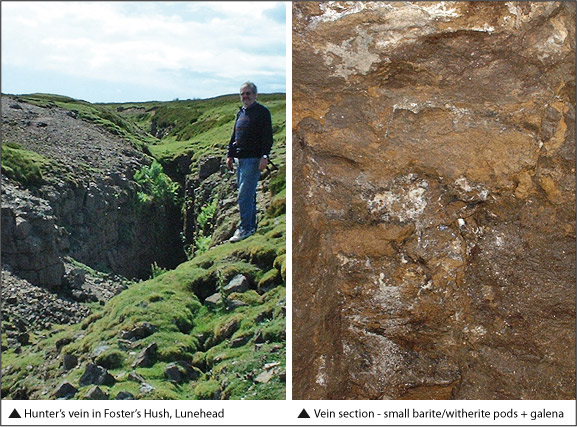
The Lunehead No. 1 vein continues N.E. as Hunter’s vein and exposed in Foster’s hush shows witherite and barytocalcite.
Safety and Access
Underground workings and mines are dangerous and should not be entered. They are unstable, often flooded and many contain toxic gases. Before visiting any quarry, mine, or mineral location permission to enter/collect must be obtained first and its SSSI status checked.
Recent Items for Sale
Minerals of the English Midlands

Mailing List
Interested in our mailing list? Get in touch via the email address on our contact page and we will add you to the mailing list.


